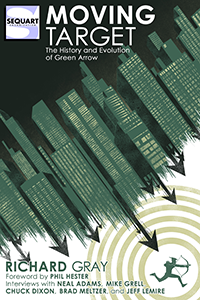Characters crossing over between shows is getting to be something of a pattern with both The Flash and Arrow. “Who is Harrison Wells?” marks the third straight episode that has featured at least one cast member crossing between series and while it’s hardly a major component of the episode, it is interesting in that the material presented does manage to enliven an otherwise undercooked installment. “Who is Harrison Wells?” is a mostly fine episode that has more than one or two gaps in logic but is ultimately carried through thanks to opportunities to see characters meet up and interact for the first time as well as the general chemistry of the cast.
It’s the latter of these two elements that takes center stage in the main plot as the team takes on a shape shifting villain. Eventually dubbed Everyman by Caitlin, the criminal otherwise known as Hannibal Bates has gone on a long string of bank robberies, framing quite a few innocents along the way as he appropriated the identities of employees to steal without fear of capture. Once Barry and company are onto Hannibal, the episode quickly becomes a game of incorporating the cast into the list of identities stolen by Everyman, slipping into the roles of Eddie, Barry, Caitlin, and Iris before the hour ends.
It’s not an unprecedented plot line. Just about every show with a supernatural or pulp milieu indulges in the body swap/shapeshifting cliché at some point, and it also comes with quite a few moments where characters seem willfully stupid to the incongruous actions of their faux-friend, but it still works because it’s driven by seeing new sides of the actors. We get to see a much glibber, callous Eddie, a smarmy Barry, and a sexpot version of Caitlin. The viewer knows it’s the bad guy at work, but there’s still the allure of seeing the actors work outside the range we’re used to seeing them in.
In much the same way the episode also manages one or two neat tricks in mixing up how the team deals with the enemy. When they first realize that their opponent can appropriate the shapes of others, Dr. Wells immediately issues a no touching rule for Barry. The team can’t know if Everyman will be able to mimic Barry’s powers if he takes his shape, and that’s not even to mention that he might find out Barry’s identity should he get a chance to mimic the Flash. It instantly changes the rules of engagement, and while the episode eventually lets Barry punch the heck out of Everyman once it’s determined that he can’t mimic powers, it establishes a new approach to the action and forces Barry into an unfamiliar situation when he and Eddie chase after a fleeing Everyman.
That’s why the sequences in Starling City pop a little bit more than they have any right to as well. The scenes are mostly just standard bits of exposition that could come off as leaden. They essentially consist solely of Joe and Cisco spending the episode digging around in the dirt as they uncover the real Dr. Wells’ body and find definitive proof that the Dr. Wells back at S.T.A.R. Labs isn’t who he says he is. The scenes do play though because they allow Joe and Cisco to play off of Quentin and Laurel Lance, characters who they haven’t yet had a chance to interact with.
The material is slight, it amounts to Quentin and Joe having a heart to heart about their respective daughters while Cisco geeks out about Laurel being the Black Canary and building her an upgraded canary cry, but the pleasure the actors are having works wonders; in particular because it’s the Lances being shown in an upbeat light. The pair has a real tendency to be among the most dour parts of a pretty dour show and seeing Paul Blackthorne and Katie Cassidy have the opportunity to brighten up makes the rote plotting worthwhile.
“Who is Harrison Wells?” pushes The Flash pretty definitely toward the first season’s end game, in particular in its final scene as Barry, Cisco, and Caitlin find Thawne’s secret room containing both the Reverse-Flash’s suit and his future newspaper, highlighting just how much the team still has to learn about Harrison and fore fronting the conflict that is still to come. The episode itself isn’t as eventful, but it still manages to excite, if only thanks to a strong set of performances from the cast and the writers’ abilities to position the characters in new ways so as to keep things feeling unique. And sometimes, that’s enough.






















































